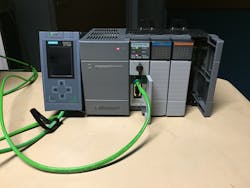Addressing Controller Interoperability
Whether you view it as a tactic to help get more of its products installed in the Rockwell Automation-centric North American market or a simple adaptation to the multi-vendor reality in plants across the world, Siemens’ approach to greater interoperability with Rockwell Automation products opens options for North American industrial facilities.
At the 2016 Manufacturing in America event in Detroit, sponsored by Siemens and Electro-Matic, Wayne Cantrell, principal systems engineer at Siemens Industry Inc., demonstrated how to connect Siemens and Rockwell Automation controllers. Using a demo of a standard boiler operation, Cantrell showed how a boiler system’s valves and pumps can be controlled using an Allen-Bradley SLC 5/05 with Ethernet and a Siemens S7 1500. In the demonstration, the controllers communicated with the system’s Siemens G120 drives via Profinet/Profidrive.
“This example shows how, for basic control operations—such as conveyor or boiler control—existing Rockwell controllers may be left in place,” said Cantrell. He also noted that Siemens WinCC Runtime Advanced HMI can communicate directly with SLC 5 controllers.
Other interoperable connections between Siemens and Rockwell Automation devices highlighted by Cantrell included: use of EtherNet/IP network to connect a Siemens S7-1500 or S7-1200 controller to Rockwell Automation’s ControlLogix; managing Rockwell multicast communications with Siemens Scalance X300 (or higher) switches; and the ability to place Siemens equipment such as drives and RFID equipment on an EtherNet/IP network.
Cantrell pointed out that Hilscher’s netTAP or Softing gateways can be used as stand-alone gateways to connect Siemens and Rockwell Automation PLCs. These gateways are “good for high-speed applications of coordinated control data,” he said.
“We can also do standard socket-to-socket TCP communications,” Cantrell added, “but that requires a Rockwell firmware upgrade to share non-coordinated control data between Siemens and Rockwell PLCs.”
An important point highlighted by Cantrell during his presentation is that the type of communication interoperability he demonstrated does not apply to safety communications or failsafe signals. He recommends hardwiring those types of communications between different controllers.
About the Author
David Greenfield, editor in chief
Editor in Chief

Leaders relevant to this article:
